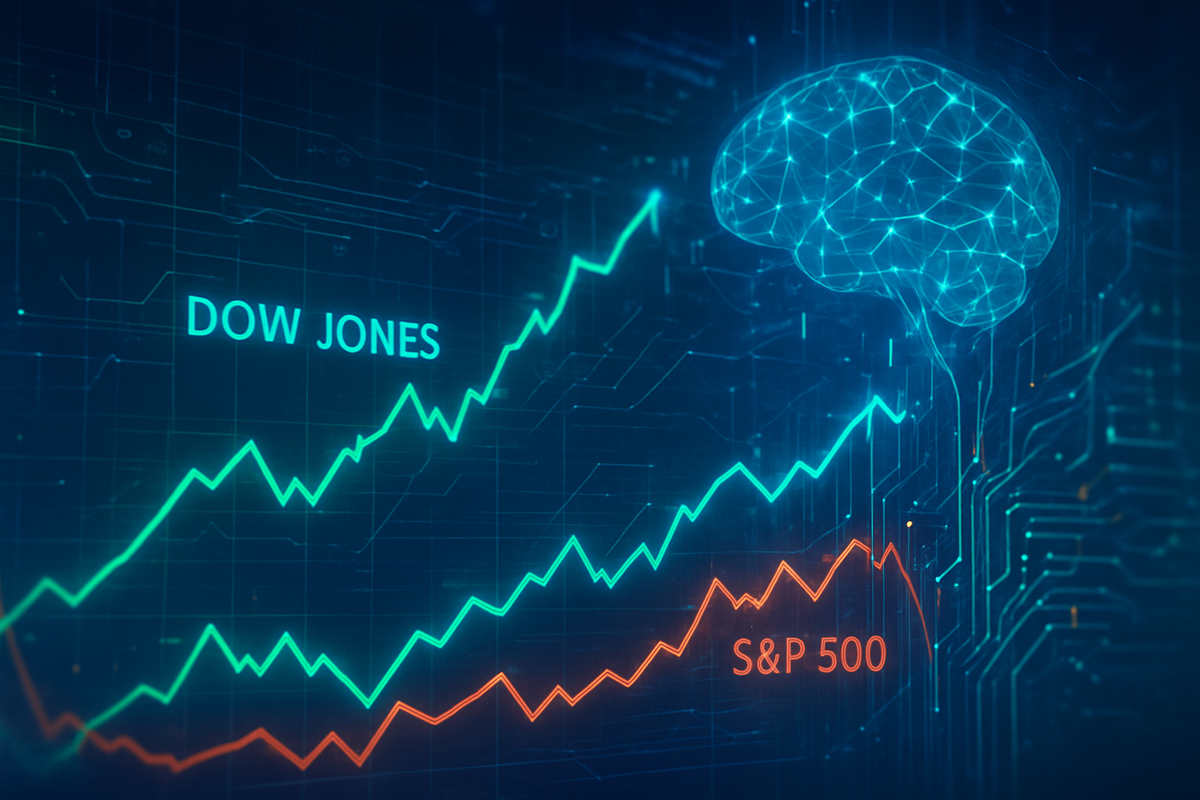
The U.S. stock market has entered November 2025 with a complex narrative, characterized by both robust bullish momentum and burgeoning concerns over valuations, particularly within the high-flying technology sector. Major global stock market indices – the Dow Jones Industrial Average (DJIA), Nasdaq Composite, and S&P 500 – have exhibited a mixed performance, largely influenced by the relentless optimism surrounding artificial intelligence (AI) but tempered by a recent tech-led sell-off. This dynamic environment suggests a market grappling with the sustainability of its recent gains and the potential for a broader recalibration.
As of early November, all three indices had concluded October with impressive winning streaks, setting the stage for what many hoped would be a strong year-end rally. However, the initial days of November have introduced a degree of volatility, with the Nasdaq experiencing a notable tumble amidst profit-taking and fears of overstretched valuations. Meanwhile, the Dow and S&P 500 have shown more resilience, indicating a potential rotation of investor interest and a broader market that is not entirely dependent on the tech sector's fortunes.
Market's Rollercoaster Ride: Early November Volatility Follows Strong October
The start of November 2025 has brought a mixed bag of fortunes for the major U.S. stock indices, following an impressive streak of gains through October. The Dow Jones Industrial Average (NYSE: ^DJIA) saw a slight dip of approximately 0.5% on both November 3rd and 4th, before rebounding modestly by 0.1% on November 5th. This came after a strong October, where the Dow advanced 2.5%, marking its longest winning streak since 2018 with six consecutive bullish months. Year-to-date, the DJIA has posted a solid return of over 11.8%.
In contrast, the Nasdaq Composite (NASDAQ: ^IXIC), heavily weighted with technology and growth stocks, experienced a more pronounced swing. After gaining about 0.5% on November 3rd, fueled by AI optimism, the index tumbled a significant 2% (486.09 points) to close at 23,348.64 on November 4th. This sharp decline was attributed to weak performance from AI infrastructure companies and escalating valuation concerns, with Nasdaq futures also showing a nearly 1% decline by midday on November 5th. Despite this recent dip, the Nasdaq had a phenomenal October, jumping 4.7% for its seventh consecutive bullish month, the longest such sequence since May 2017, and boasting a year-to-date gain of nearly 22%.
The S&P 500 (NYSE: ^GSPC) mirrored the broader market's sentiment, showing minor gains of 0.2% on November 3rd and 4th, closing at 6852. However, it then slid 1.2% to 6,771.55 on November 4th, before recovering 0.5% on November 5th. The S&P 500 also had a robust October, gaining 2.3% and extending its winning streak to six months, its longest since 2021, with a year-to-date return of over 16%. The index is currently eyeing the 7000 level, potentially setting new all-time highs.
The overarching narrative leading up to this moment has been the AI-driven growth, with major AI-related deals, such as Amazon's (NASDAQ: AMZN) cloud services agreement with OpenAI, significantly boosting sentiment around companies like Amazon and Nvidia (NASDAQ: NVDA). This has led to an increasing concentration of market capitalization in a few mega-cap stocks. However, this momentum has been met with growing valuation concerns from several major investment banks, triggering profit-taking and the recent tech sell-off. The third-quarter earnings season has been a significant tailwind, with the S&P 500 reporting double-digit earnings growth for the fourth consecutive quarter, largely driven by the Information Technology and Financials sectors. The Federal Reserve's recent 25 basis point rate cut and expectations of further cuts have also fueled optimism, though mixed economic data and an ongoing government shutdown have introduced elements of uncertainty.
Winners and Losers in the AI-Driven Market
The current market dynamics, characterized by AI-driven enthusiasm and simultaneous valuation concerns, present a clear dichotomy for public companies. Technology giants deeply entrenched in the artificial intelligence ecosystem are poised to be the primary beneficiaries, even amidst recent volatility. Companies like Nvidia (NASDAQ: NVDA), a leading designer of graphics processing units (GPUs) essential for AI, continue to be at the forefront of the AI buildout boom. Similarly, cloud service providers such as Amazon (NASDAQ: AMZN) through AWS, and Microsoft (NASDAQ: MSFT) through Azure, are direct winners as demand for AI infrastructure and services escalates. These companies benefit from long-term contracts and the foundational role they play in the AI revolution. Their strong third-quarter earnings, as highlighted in the research, underscore their current robust performance. However, the recent tech-led sell-off on November 4th indicates that even these high-flyers are not immune to profit-taking and investor jitters regarding stretched valuations. Companies with less robust fundamentals or those whose growth prospects are already priced for perfection face significant downside risk if the market undergoes a broader correction.
Conversely, companies whose valuations have become significantly inflated solely based on speculative AI potential, without demonstrable revenue or profit growth, could face substantial headwinds. While not explicitly named as "losers" in the research, the general sentiment around "valuation concerns" suggests that a correction could disproportionately affect smaller, less established AI firms or those with high price-to-earnings ratios. Furthermore, companies in traditional sectors that have not fully embraced or integrated AI could find themselves at a competitive disadvantage in the long run, facing efficiency gaps and slower innovation.
The financial sector has shown notable resilience, helping the Dow outperform amid the tech sell-off. This suggests that established financial institutions like JPMorgan Chase (NYSE: JPM), Bank of America (NYSE: BAC), and others, which contribute significantly to the Dow's performance, might be viewed as safer havens or beneficiaries of a potential rotation out of overvalued tech stocks. Strong earnings reported by several financial institutions further solidify their position. This resilience could also extend to other value-oriented sectors or companies with stable cash flows and attractive dividends, as investors seek diversification away from growth-at-any-cost narratives. The market's current state implies that a balanced portfolio approach, incorporating both growth and value, might be prudent in navigating the emerging volatility.
Broader Implications: AI's Reshaping of Market and Economy
The current market landscape, marked by the fervent pursuit of AI-driven growth alongside escalating valuation anxieties, fits squarely into a broader trend of technological disruption and its economic consequences. This dynamic is not merely about specific stock movements; it represents a significant shift in capital allocation towards sectors perceived as future-proof, primarily driven by artificial intelligence. The increasing concentration of market capitalization in a few mega-cap tech stocks, as highlighted by the research, underscores a "winner-take-most" phenomenon, where companies with early leads in AI infrastructure and applications command disproportionate market influence. This trend raises questions about market breadth and the overall health of an economy where growth is heavily reliant on a select few entities.
The ripple effects of this scenario are far-reaching. Competitors, particularly smaller tech firms or those in traditional industries, face immense pressure to innovate and integrate AI to remain relevant. Companies that fail to adapt risk becoming obsolete, potentially leading to industry consolidation or significant market share losses. Partners in the supply chain for AI, such as semiconductor manufacturers beyond Nvidia, or specialized data centers, stand to benefit from the sustained buildout. However, the reliance on a few dominant players also creates systemic risks; any significant setback for a mega-cap AI leader could send shockwaves across the entire tech ecosystem and beyond. The recent tech sell-off on November 4th serves as a potent reminder of this interconnected vulnerability.
Regulatory implications are also emerging as a critical consideration. The immense power and market concentration of AI giants could attract increased scrutiny from antitrust regulators globally. Concerns about data privacy, algorithmic bias, and the potential for monopolistic practices are likely to intensify, potentially leading to new regulations or enforcement actions that could impact these companies' growth trajectories. Furthermore, the role of central banks, like the Federal Reserve, in managing economic stability amidst such rapid technological shifts, becomes more complex. Their rate decisions, aimed at controlling inflation or stimulating growth, now also interact with a market heavily influenced by speculative technology trends.
Historically, periods of intense technological innovation, such as the dot-com bubble of the late 1990s, offer cautionary tales. While the current AI boom is underpinned by more tangible technological advancements and corporate earnings, the rapid ascent of valuations and the speculative fervor bear some resemblance. The key difference lies in the profitability and established market positions of many current AI leaders. However, the historical precedent suggests that even revolutionary technologies can experience periods of significant market corrections when valuations detach too far from fundamentals, underscoring the need for investor vigilance.
The Road Ahead: Navigating Opportunities and Challenges
Looking ahead, the U.S. stock market appears poised for a period of continued navigation between the undeniable promise of artificial intelligence and the inherent risks of elevated valuations. In the short term, investors will be closely watching for signs of whether the recent tech-led sell-off on November 4th was a temporary profit-taking event or the precursor to a more significant correction, particularly in the Nasdaq. The resilience shown by the Dow and S&P 500 on November 5th suggests a potential for rotation into less growth-dependent sectors, or a broadening of the rally beyond just mega-cap tech. Key economic data releases, especially those related to inflation and employment, will continue to influence Federal Reserve policy, with further rate cuts anticipated but contingent on data. The resolution of the ongoing government shutdown will also be crucial for market clarity and the release of delayed economic indicators.
In the long term, the trajectory of AI development and adoption will remain the dominant theme. Companies deeply invested in AI research, development, and deployment will likely continue to outperform, provided they can translate innovation into sustainable revenue and profit growth. This will necessitate strategic pivots for many corporations, focusing on integrating AI across their operations to enhance efficiency, drive new product development, and gain competitive advantages. Those that fail to adapt risk falling behind, making AI integration a strategic imperative rather than an optional enhancement.
Market opportunities will likely emerge in areas beyond the immediate AI infrastructure providers. This includes companies developing specialized AI applications for various industries (healthcare, finance, logistics), cybersecurity firms protecting AI systems, and businesses providing the necessary data and talent for AI development. Conversely, challenges will include managing the increasing regulatory scrutiny on AI, addressing ethical concerns, and navigating potential market saturation or increased competition as more players enter the AI space. Potential scenarios range from a sustained, albeit volatile, bull market driven by continued AI innovation and robust corporate earnings, to a more significant market correction if valuation concerns intensify or if economic growth falters unexpectedly. Another scenario involves a "soft landing" where the market experiences a healthy rebalancing, with value stocks gaining ground and tech valuations normalizing without a severe downturn. Investors should prepare for increased volatility and the need for dynamic portfolio management.
Conclusion: A Market in Transition
The early days of November 2025 have underscored a pivotal moment for global stock markets, characterized by a delicate balance between the transformative power of artificial intelligence and the growing unease surrounding market valuations. The key takeaway is the dual nature of the current market: while AI continues to be an undeniable engine of growth, propelling indices like the Nasdaq to historic highs, it also introduces a concentration risk and vulnerability to swift corrections, as evidenced by the November 4th tech sell-off. The resilience of the Dow and S&P 500, supported by strong corporate earnings and the performance of sectors like financials, highlights a broader market that, while influenced by tech, is not solely dependent on its most speculative elements.
Moving forward, the market will likely remain in a state of dynamic tension. Investors will need to closely monitor the sustainability of AI-driven earnings, the broader economic landscape, and the Federal Reserve's monetary policy decisions. The expectation of further rate cuts could provide a tailwind, but mixed economic signals and potential regulatory interventions could introduce headwinds. The market's ability to broaden its rally beyond a few mega-cap tech stocks will be a crucial indicator of its underlying health.
The lasting impact of this period will likely be the accelerated integration of AI across all industries, fundamentally reshaping business models and competitive landscapes. Companies that strategically embrace AI and demonstrate clear pathways to profitability will thrive. For investors, vigilance is paramount. They should watch for shifts in market leadership, signs of economic deceleration or acceleration, and any significant policy changes affecting the tech sector. A diversified approach, balancing exposure to innovative growth companies with stable, value-oriented firms, appears to be the most prudent strategy in this evolving and occasionally turbulent market environment.
This content is intended for informational purposes only and is not financial advice





